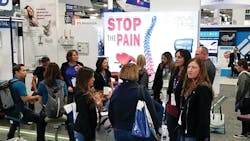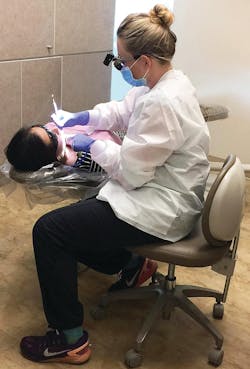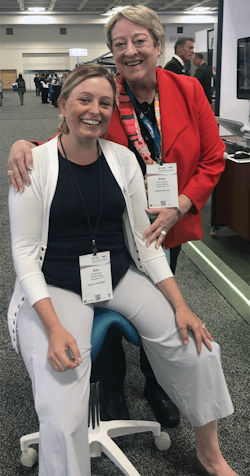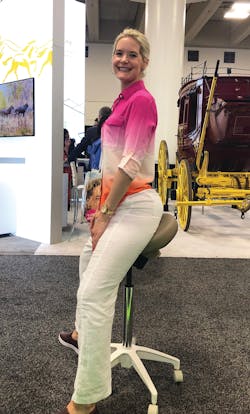The changing landscape: Hygienists are becoming serious purchasers
Ten years into my clinical career, I started noticing aches and pains. At the end of a clinical day, the muscles in my neck, shoulders, and back were in knots. At first, I was able to escape the discomfort when I went to sleep, but eventually I began to wake up numerous times at night with cramps in my elbow and a neck that hurt at the slightest turn. Over the next five years, the list of body parts that were screaming got longer and longer.
Back in the sixties, no one talked about getting hurt. My body was rebelling. Four eight-hour days were too much. I was desperate, and how I felt was affecting my interaction with others. Crabby Anne was a constant and unwelcome companion.
Investing in health
After 15 years in my initial office, I moved on in 1988. Both dentists at the new office wore loupes. I had never seen dental magnification, but over time it started to make sense. So, I went to a meeting and bought my first pair of loupes and a safer operator chair with arms. A year later I added a headlight. People laughed at me. Patients stared in wonderment. Colleagues thought I was nuts, but I felt better physically and mentally.
Some hygienists accused me of ruining dental hygiene, thinking doctors would now expect hygienists to purchase their own equipment. While these accusations hurt, there was no reason to apologize for trying to take care of myself. I chose to ignore people who thought my actions were wrong. It was a lonely place to be for a long time.
Fast-forward to today. More and more dental hygienists are now taking charge of their own physical health, and more and more are making their own purchases. Clinicians are now seeking out companies that make products that create and support a healthy workspace. Hygienists are actively looking for products that provide the right physical fit with price points that work well in their budgets.
Purchasing changes
Attending a large conference, such as RDH Under One Roof or the recent ADA Annual Meeting, is one of the best ways to compare products. In the past, vendors could spot hygienists from a mile off just by looking at the color of their badges. In the old days, salespeople would ignore a dental hygienist in favor of having a conversation with a doctor. Companies simply did not believe that a dental hygienist would ever be a serious customer. But the landscape is changing. Manufacturers now recognize dental hygienists are interested in purchasing products. Companies that are paying attention to our clinical needs are gaining a very loyal fan base. Social media is keeping the conversation going between meetings.
Other factors are also facilitating change. An increasing number of hygienists are no longer content to put up with the clinical equipment supplied by dental offices. Hygienists want to work with companies that take our needs seriously and are willing to do business with us. There are now many companies that make it easy for hygienists to make direct purchases. With the growing popularity of teledentistry and improved access to care, more hygienists than ever will become direct purchasers.
Another change is popping up. Hygienists with their own equipment are perfectly positioned to educate those around them about the value of workplace safety. I’ve heard many stories about fellow hygienists and even doctors adopting magnification, lighting, or saddle seating after working with a fellow clinician who uses these tools.
Comparing options
2019’s ADA meeting was a perfect example of how savvy we have become as purchasers. For a week before the meeting, a number of hygienists reached out to me with questions about magnification, lighting, and seating. Their reasons were all different. For some, the meeting would be their first purchasing experience, and for others, it was an opportunity to upgrade to a better or safer product. Here are some marvelous examples of how equipment ownership can be so empowering.
Erin has been practicing dental hygiene in Sacramento for a number of years. Several years ago, she got concerned about the risks for developing a musculoskeletal disorder, so she purchased a pair of inexpensive loupes. She also purchased a saddle stool from a site on Amazon that sold products for workers in the beauty industry.
Erin’s plan seemed reasonable, but over time her aches and pains increased, clearly an alarming trend. She was now seeing a chiropractor and physical therapist several times a week to deal with her discomfort. Erin contacted me a few weeks before the September ADA Meeting and sent several photos, which clearly showed positioning issues. The photos showed a working distance and a declination angle that were not optimal. Her loupes required her to position her patient too high, and work with a forward head posture and flexed neck just to see through the oculars. The saddle stool had a prominent front end, and the seat pan tilt could not be adjusted to allow Erin to sit in a neutral posture. Sadly, the equipment was contributing to her discomfort. Erin realized the importance of getting fitted for products that could help her, not hurt her.
Premeeting diagnostics
Two of the images Erin sent showed her using a traditional operator stool as well as a saddle stool. The images revealed the following information:
- The seat pan is deep. In an attempt to get closer to the patient and not bump the front end of the operator stool into the patient chair, Erin sits closer to the front edge, a positioning technique that cuts off circulation in the back of the legs.
- The working distance on the loupes is too shallow, requiring a high patient position. It is ideal to have the patient’s mouth at the same height as the operator’s waistline.
- In order to accommodate the patient position, Erin’s right arm is reaching forward, her left arm is flexed upward at the elbow, and her left wrist is flexed.
- The declination angle of the loupes is too shallow, forcing Erin to use a forward head posture and flexed neck.
- Erin’s upper torso is leaning forward, resulting in rounded shoulders.
- Erin is sitting closer to the patient, but this saddle design has a prominent front end that does not allow her to get closer.
- Erin’s upper torso posture is more erect, and her shoulders are less rounded.
- The working distance and declination angle of the loupes still compromise her positioning.
- The nonadjustable saddle seat pan is angled too far forward for Erin’s hips and torso.
Meeting becomes an educational opportunity
Erin’s doctor is a petite woman, with a narrow pelvis. The Western saddle design fit her perfectly. The office’s dental assistant learned that there are assisting chairs that are designed to maintain balance and prevent falling forward onto a patient. Erin and the other hygienist found saddles that worked for their individual torsos. The saddle that worked well for Erin is a middle-of-the-road design with a seat pan width that falls between the narrow Western and the wider modified English model (figure 4). This saddle provides optimal hip and thigh support with a low front profile, allowing her to sit closer to her patients. It was a fabulous educational moment when everyone realized that their individual seating needs were unique. Erin and her coworkers now have a plan to adopt safe seating options in their practice.
A case for a custom fit
Kristen Ohlde, RDH, realized that her clinical posture would be playing a key role in her successful recovery from a recent surgery and knew that it was critical for her to maintain a neutral body posture when she returned to clinical work. Kristen’s postural needs were very precise, and when I suggested she attend the ADA, she immediately put a plan in motion. I encouraged her to bring her loupes to the meeting to ensure that the working distance and declination angle were optimal.
What makes Kristen’s story so unique is its timeline. After our conversation, Kristen booked a round-trip flight to spend the next day at the ADA to research her seating options and to ensure that her current loupes were working well for her. While it may seem extreme to book a last-minute trip like this, I assured her that in one day, she could meet with a number of companies and get her questions about obtaining an optimal fit answered.
The plan was successful. Kristen had her loupes evaluated by a seasoned company representative. It turns out the loupes Kristen purchased a few years ago as a student were fine, a very reassuring piece of news.
Kristen’s seating requirements were more complicated. She has a narrow pelvis, an average torso length, and very long legs, measurements that mean standard, run-of-the-mill seating would never allow her to achieve a neutral posture. Her quest was successful! She found a seat that fit her torso and leg length and allowed her to use a healthy, neutral seating posture (figure 5). Mission accomplished.
What is in the future?
The idea of purchasing equipment and ownership was totally foreign several decades ago. Today, more hygienists are taking charge of their careers by selecting and purchasing equipment that fits their personal needs. Make sure to get an agreement in writing with your employer. If you choose to follow this pathway, here are some important agreements that need to be set in place up front to avoid any misunderstandings in the future.
- Who pays for equipment maintenance or repairs?
- Will others expect to use equipment that you purchased?
- Who pays for disposable items used with the equipment, such as ultrasonic inserts or prophy angles?
- If the doctor or practice paid for a percentage of the equipment, agree on a date when you will own the equipment outright.
- Is there additional financial compensation for providing your own equipment?
Tax implications and how to make a purchase
In the past, hygienists who purchased their own equipment were eligible to take a tax deduction on an itemized form. The 2018 tax law changes eliminated that option.
Purchasing is both easy and complicated. Some products can be purchased directly from the manufacturer. In this situation, payments are generally made with a credit card. For larger capital purchases such as loupes, lights, or a saddle stool, many companies are structured to offer interest-free payment plans.
Dental supply companies are quite different. While a growing number of companies value our business, many are structured to work with clients such as dentists who have regular large orders for both supplies and equipment. Dental hygienists typically make occasional purchases, but some supply companies now welcome our business, even if it is less frequent.
Success at the meeting
It pays to ask questions and compare purchasing options. And it pays to try out equipment options firsthand rather than relying soley on a coworker’s recommendation or a review online. And a real bonus for attending a live meeting is networking with all of the wonderful dental professionals who are as passionate about dentistry and dental hygiene as you are.
ANNE NUGENT GUIGNON, MPH, RDH, CSP, provides popular programs, including topics on biofilms, power-driven scaling, ergonomics, hypersensitivity, and remineralization. Recipient of the 2004 Mentor of the Year Award and the 2009 ADHA Irene Newman Award, Guignon has practiced clinical dental hygiene in Houston since 1971. You may contact her at [email protected].
About the Author
Anne Nugent Guignon, MPH, RDH, CSP
ANNE NUGENT GUIGNON, MPH, RDH, CSP, has received numerous accolades over four decades for mentoring, research, and guiding her profession. As an international speaker and prolific author, Guignon focuses is on the oral microbiome, erosion, hypersensitivity, salivary dysfunction, ergonomics, and employee law issues. She may be contacted at [email protected].






